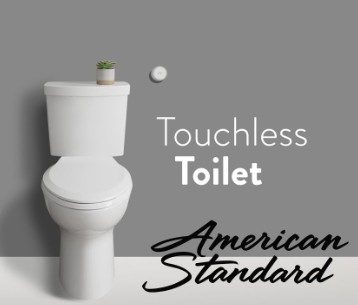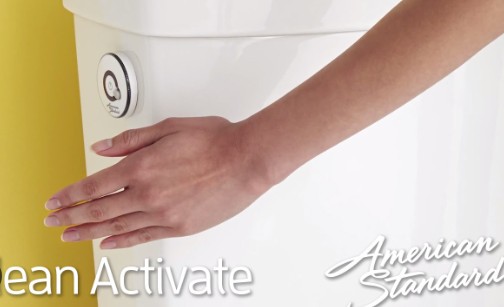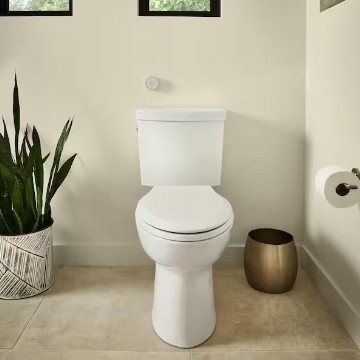The ingenuity of touchless toilets is pretty impressive as it means you no longer have to touch the toilet handle or button to flush. This technology is undoubtedly advantageous, but it doesn’t mean these toilets are immune to problems, so what are the American standard touchless toilet problems?
The various problems you can encounter with an American Standard touchless toilet are sensor malfunction, water continuously running, battery issues, and no power supply. Also, it can develop a weak flush, water leakage, frequent false flushing, and unusual noises.
Now that you know the gist of these issues, let’s examine them in detail in the subsequent sections. This way, you can keep enjoying this hygienic and convenient toilet.

American Standard Touchless Toilet Problems & Fixes
| Problem | Possible Reasons | Recommended Fixes | |
| 1. | Sensor Malfunction | Dirty or obstructed sensors Low battery power Sensor misalignment Interference from external light sources | Gently clean the sensor area Replace the batteries Realign the sensor Adjust your bathroom lighting, ensuring it is not lowly lit or excessively lit |
| 2. | Battery Issues | Using the wrong batteries Low or dead batteries Corroded or dirty battery contacts | Use the batteries recommended for American Standard touchless toilet Replace depleted batteries Clean the corroded or dirty parts |
| 3. | No Power Supply | Installing the batteries wrongly Corrosion or loose connections | Install the batteries properly Clean the battery terminals |
| 4. | Water Continuously Running | A stuck handle or button The flapper or flush valve seal doesn’t seal well High water pressure A faulty fill valve | Release a stuck handle or button Replace a worn-out flapper or flush valve seal Regulate water pressure with a pressure regulator Replace a damaged flash valve |
| 5. | Weak Flush | Low water level Blocked rim holes and jets A faulty flapper or seal An obstructed trapway High water pressure | Adjust the float or float valve Clean the rim holes and jets Replace a defective flapper or seal Clear the trapway Install a pressure regulator |
| 6. | Water Leakage | Loose bolts Damaged wax ring Cracked toilet bowl Faulty water supply | Tighten the bolts Replace the wax ring Replace the toilet bowl Install a new supply line |
| 7. | Frequent False Flushing | Dirty, damaged, or obstructed sensor Reflective surfaces Strong air currents | Clean or replace the sensor Cover or move reflective surfaces Minimize drafts near the sensor |
| 8. | Unusual Noises | Mineral deposits or debris on the fill valve Malfunctioning flush valve Water hammer | Clean the fill valve Repair or replace the flush valve Install a water hammer arrestor |
1. Sensor Malfunction
The sensor is a primary and integral part of a touchless toilet. It detects when you approach or leave the toilet and triggers the flushing mechanism accordingly.
Therefore, sensor malfunctions can be frustrating since they can result in either frequent or no flushes at all. Potential causes for sensor problems include:
a) Dirty or Obstructed Sensors
Over time, sensors can accumulate dirt, dust, or debris, hindering their performance by obstructing the toilet’s ability to detect motion accurately.
b) Low Battery Power
American Standard touchless toilets rely on batteries to power the sensor. The sensor may not function correctly if the batteries are low or dead.
c) Sensor Misalignment
Check if the alignment between the sensor and the toilet bowl is correct. A misaligned sensor may not detect your presence accurately.
d) Interference from External Light Sources
Strong natural or artificial light sources can sometimes inhibit the sensor’s operation.
Fix
- Use a soft, damp cloth to clean the sensor area gently. Avoid harsh chemicals or abrasive materials since they can destroy the sensor. Ensure the sensor is completely dry before testing it.
- Replace the batteries. In addition, ensure the battery compartment is clean and free of corrosion.
- Check and adjust the sensor’s alignment (refer to the manufacturer’s manual) if it’s misaligned. Make sure it can effectively detect the user’s movements.
- Adjust the lighting conditions in your bathroom accordingly. The toilet area should be adequately lit but not overly bright.
- Clear any obstacles, such as toiletries, towels, or curtains, are blocking the sensor’s view.
- Your American Standard touchless toilet could use a sensor reset if they have been experiencing consistent issues. Get the instructions for resetting the sensor from your toilet user manual. Resetting the sensor can sometimes recalibrate the sensor and resolve malfunctioning issues.
2. Battery Issues
Battery issues can disrupt the sensor’s functionality in your American Standard touchless toilets and, in turn, affect the toilet’s automatic flushing system. When the batteries run low or die, your toilet can develop problems such as inconsistent flushing or sensor malfunctions.
Also, you can attribute your toilet’s poor performance to the wrong type or low-quality batteries. Moreover, corroded or dirty battery contacts can impede power flow from the toilet’s batteries to the sensor.
Fix
- Use the batteries recommended by the manufacturer.
- Replace depleted batteries. The sensor on your American Standard touchless toilet will blink red every time you flush when the batteries run out.
- Clean the battery contacts. However, before doing so, turn off the power to the toilet, remove the cover or access panel to access the battery compartment, and then remove the batteries. After that, use a soft, dry cloth or a cotton swab to clean the battery contacts inside the sensor and the battery compartment, then insert new batteries and ensure they are correctly seated.
3. No Power Supply
Your touchless toilet can completely lose its functionality if it has no power supply. Power supply issues in an American Standard touchless toilet can be caused by different reasons, such as failing to install the batteries correctly.
Battery compartment issues, like loose connections or corrosion, can also cause this problem. These issues can prevent the power from reaching your toilet’s sensor and flushing mechanism.
Fix
- Connect the batteries correctly if they are improperly installed.
- Open the battery compartment, then examine the terminals. Clean them if they are corroded. Also, close the battery compartment securely, ensuring it makes good contact.

4. Water Continuously Running
This issue is both frustrating and wasteful, yet relatively common. It can lead to higher water bills and potential damage to your toilet, so knowing how to fix it is a skill you should strive to have.
A common reason for a continuously running toilet is a flapper or flush valve seal not sealing properly after flushing. The flush valve seal can deteriorate, leading to water leakage and continuous flushing.
The handle or button on your toilet tank can also get stuck in the flush position, leading to continuous flushing. In addition, you should check for high water pressure or a faulty fill valve.
Fix
- Make sure the handle or button is not stuck.
- Look for any signs of damage, warping, or deterioration on the flapper or flush valve seal. Replace the flapper or seal if worn out or damaged.
- Adjust the chain if it is too long or short to provide some slack while still allowing the flapper to seal completely.
- Replace a faulty fill valve and make sure the water level in the tank is set to the correct level.
- Also, use a pressure regulator to reduce the water pressure to a safe and suitable level for your toilet.
5. Weak or Incomplete Flush
Another common issue you can run into with your American Standard touchless toilet is a weak or incomplete flush. This problem can cause waste to linger on the bowl after flushing; hence, you will require multiple flushes to clear the bowl.
If you encounter this problem, check inside the tank to see if the water level is low. It should be at or near the fill line.
Also, inspect the rim holes and jets for mineral deposits, debris, or sediment buildup, as they can restrict the flow of water during flushing, leading to a weak flush.
Moreover, a weak flush can be caused by a damaged or improperly seated flapper or flush valve seal, partial blockages in the trapway, or high-water pressure.
Fix
- Adjust the float or float valve to increase a low water level.
- Clean the rim holes and jets using a flexible, thin brush or wire hanger.
- Replace a faulty flapper or seal.
- Clear an obstructed trapway with a plumber’s snake.
- Lower the water pressure to the appropriate levels by installing a water pressure regulator in your plumbing system.
6. Water Leakage
Besides increasing your water bill, water leaks from your American Standard touchless toilet can lead to water damage and mold growth. If you notice water pooling around the base of your toilet, check the toilet’s mounting bolts and nuts and inspect the toilet bowl for cracks or fractures.
In addition, examine the wax ring for damages and the water supply connection for any faults.
Fix
- If mounting bolts and nuts are loose, tighten them gently but not excessively to avoid damaging the toilet or the flange.
- Replace a damaged wax ring because it will allow water to seep.
- Replace a cracked toilet bowl.
- Replace the supply line or connection if faulty.

7. Frequent False Flushing
Like continuous running, false flushing can be wasteful and annoying. It refers to a situation where your toilet flushes on its own without your interaction.
In a touchless toilet, false flushes can occur due to a dirty, obstructed, or damaged sensor or a nearby reflective surface bouncing infrared light and confusing the sensor. Also, strong air currents in the bathroom can trigger the sensor.
Fix
- Clean the sensor and the surrounding area thoroughly.
- Cover or reposition any reflective surfaces.
- Minimize drafts near the toilet sensor and keep your bathroom ventilated.
8. Unusual Noises
Strange noises, such as gurgling or whistling from your touchless toilet, can be unsettling. These noises may occur due to mineral deposits or debris in the fill valve, a malfunctioning flush valve, or a water hammer.
Fix
- Remove the fill valve cap and clean it thoroughly. If the noise persists, get a new fill valve.
- Ensure the flush valve is working correctly and the flapper seals properly after each flush. If faulty, replace it.
- Install a water hammer arrestor to mitigate the effects of the water hammer.
Summary of American Standard Touchless Toilet Problems
By following the above troubleshooting tips, you can address common problems that might crop up in your American Standard touchless toilet. Remember that, like any other technology, touchless toilets occasionally encounter issues.
Also, Read:
